For most of you who have been following my blogs for a while now, it must be a known fact that I have always been fascinated by the Japanese culture.
There is something in their way of approaching things, which sets them apart from the rest of us. Their beliefs, principles, philosophies are always so amusing that it actually makes me wonder the enormous amount of values they have, for almost everything!
I also like to read about Japan even if it goes wayyy back into history. The older, the better :) Since, I am also studying interiors, I can't help but go back again and again to the tea houses and the tea ceremonies.
A tea room or a Chashitsu is a room where the tea ceremony is hosted as per the Japanese culture.
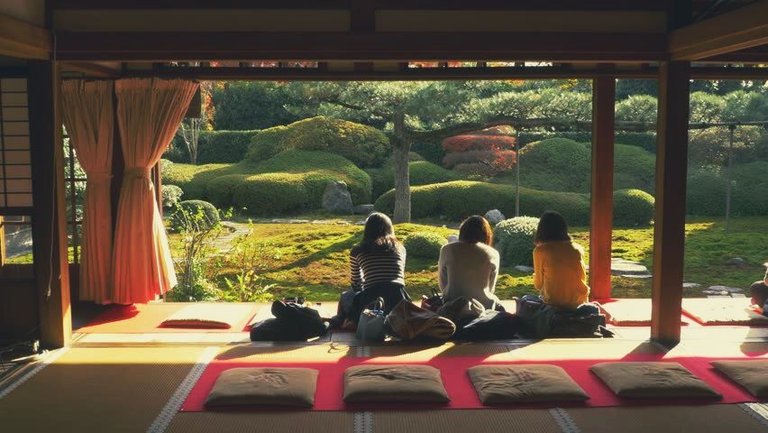
While studying indepth about how the tea houses were made, I was amazed by the planning of the layouts. The division of space was THE most important criteria which decided how it was going to be used by the people for the ceremony. The Japanese used tatami mats which decided the layout of a room which also varied according to regions. The following image is the layout of a 4½ mat tea room.
(4½ mats = 9 shaku × 9 shaku ≈ 2.73 m × 2.73 m) 1 shaku roughly measures around a feet.
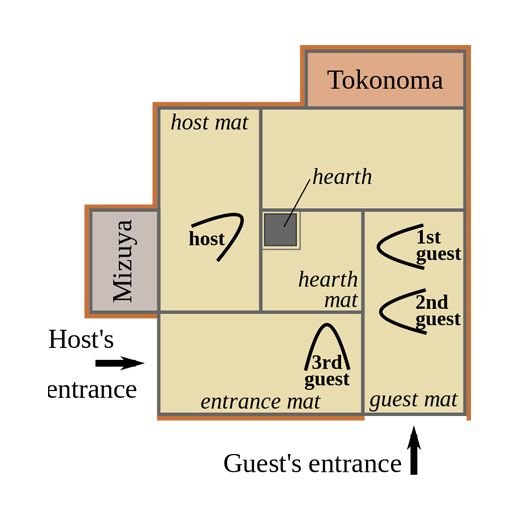
What is most interesting to me is how the small details in the interior and exterior practically defined everything. The interiors were planned in such a way which visually segregated the space for the host and the guest/guests. Even the elements in the tatami mat played a crucial role in defining the Japanese etiquettes and beliefs. For example: Stepping on the border of the mat was considered ungraceful and the arrangement of the same also defined the auspiciousness/inauspiciousness of any occassion.
ELEMENTS OF A CHASHITSU
TOKONOMA
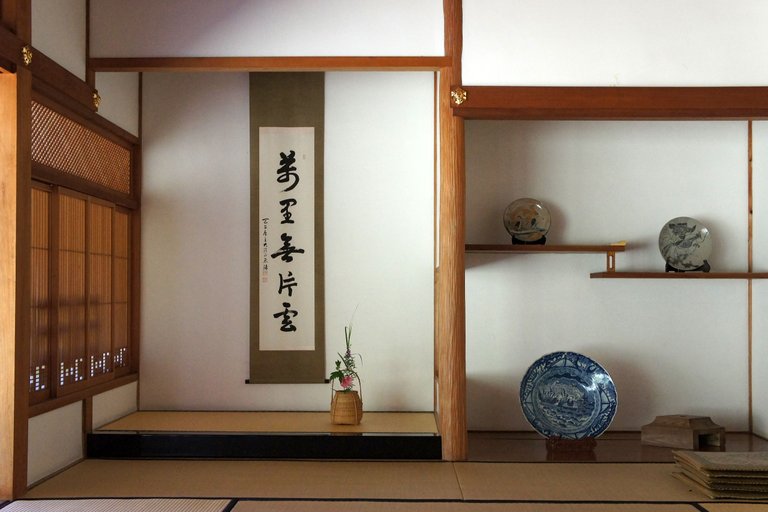
A tokonoma is a portion of the room which is slightly raised in comparison to the rest of the floor. It contains a scroll with religious text and/or a flower arrangement. The important thing to understand here is the most important guest is seated, facing away from the tokonoma as a sign of modesty. In the interior space, the ceilings are intentionally made in different levels so as to give the illusion of a large space/small space depending on the area itself.
MIZUYA
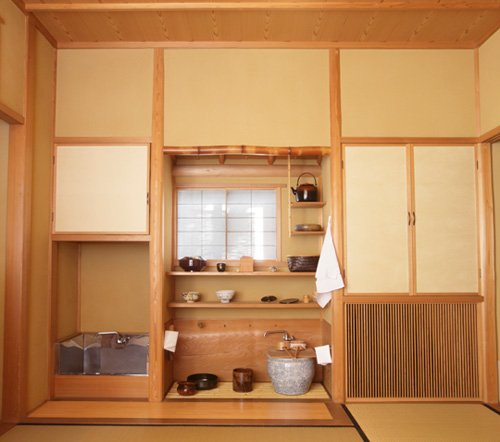
This part of the room is concerned with all preparation activities related to the tea making, for example: Boiling extra water required for tea. It should be always kept clean and ready and it generally doesn't contain a furnace. In the past however, the preparation was done on the veranda as there was no place assigned inside for this.
HEARTH
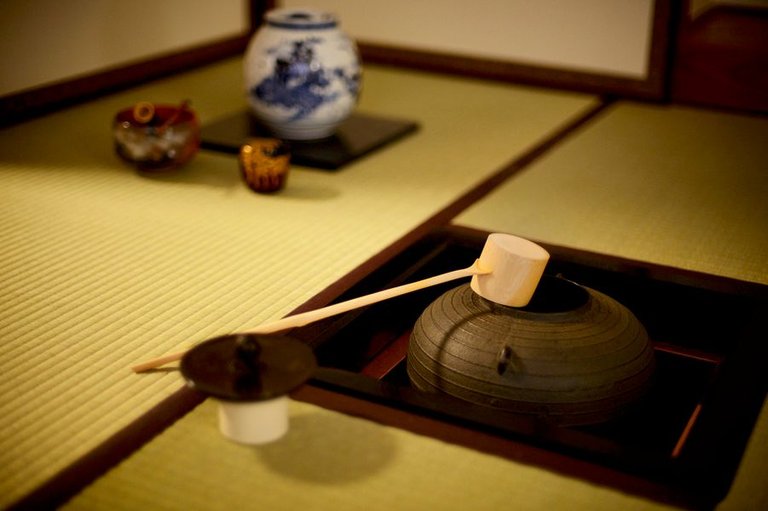
The use of hearth depends on the changing of seasons. It is a little lower than the rest of the floor and is used in winters. In the summer seasons it is covered with tatami mats as it is replaced by a portable stove a.k.a furo.
The entrances for the host and guests are different. A small entrance is opened for the guests in which they have to bend and enter the interior space. This shows that everyone is equal according to the etiquettes of the ceremony and it gracefully separates the outside world from the inside. During the ceremony, everyone sits in the traditional way of seating which is known as seiza style. Shoji screens are used as doors and partitions to subtly reduce but maintaining adequate light and ventilation in the room.
There is much more to the architecture along with the tea ceremony which is associated deeply with it's history. I am currently trying to understand what the concept of wabi-sabi is and how it affected the lifestyle of the Japanese and also the tea ceremony. Will be back with more information of the same!
Keep Creating
Lots of Love <3
Its really amazing....a well informative post....Its so nice to see that you know so much about Japanese culture.
As a Turkish person it is very important thing making tea and drinking it any time of the day ! But i heard about the differences of boiling tea Country by country...For example in Turkiye we generally use black tea (of course we use green tea but not common like the black tea) and i want to tell how we prepare our tea: first boiling the water and then pouring the boiling water on the tea then again fill the boiling pot fresh water and let it boil again but on the top also boil the hot tea with boiling waters steam with low heat about ten or fifteen minutes...And then we drink it :)
thank you for your beautiful sharing about tes culture and have a nice day my friend...
Very interesting! Keep it up! <3

It was a pleasure to read. Japanese traditions always looked so mysterious and romantic to me. Really nice to learn something new.
I spent a year in Korea and was only able to travel to Japan once for a basketball tournament. Your pictures get me inspired to go back. Thank you for sharing!
Ahh brings back old memories, remember when I was in Japan a couple of years back and I visited a tea house, I was quite stunned when I got a cup of tea looking like green goo, I wish I could say it tasted well but I just tried to do my best aligned with the Japanese culture - so I smiled big while sipping on my cup, trying not to throw up haha 😂
Quite an experience although😉
For sure the Japanese people are one interesting kind of people. Your post is sure dishing out information not readily known to us. Thanks a lot.
Tea <3
Awesome! An informative post. I've a huge interest in Japan and Japanese culture too, including the language.
I'm currently learning it through an amazing and easy app called Human Japanese. I'm sure you'd be interested too, so do check it out! :)
Finally I get to know someone in the family who loves Japan as much as I do. Cries in Japanese <3
The Japanese people are so thoughtful when it comes to efficient design.
I was just in Japan for travel. I love how organized and well functioning Tokyo was. Everything is so optimized for the amount of people in that city.
I love the Japanese culture too! They are awesome people! :)
What a fine, interesting post. It's well-written and with great photos and graphics, too.
You should consider writing a post about the tea ceremony itself. It's origins go back hundreds of years, and it's still practice by many.
Looking forward to your wabi-sabi post. (You might also be interested in the concept of "furyu."
A stone water trough in front of the entrance to a chashitsu - tea room. Before guests enter, they wash their hands & rinse their mouths. This custom comes from the Shintō act of purifying oneself with water before entering a shrine.
Really good concept, I am waiting for your next article. Thank you.
I am very interested in japanese culture. I have never been in Japan, but thanks to sharing, I have some ideas.
I love sharing. thanks my dear friend
Such order, harmony, and discipline!